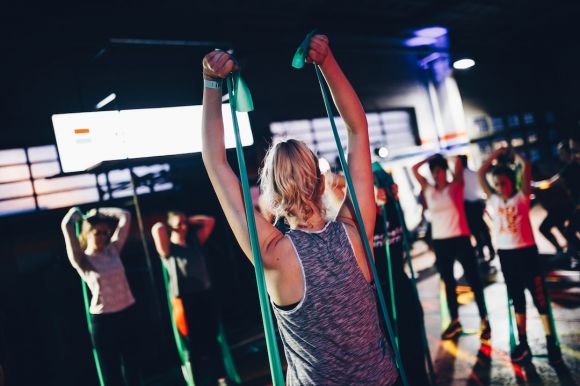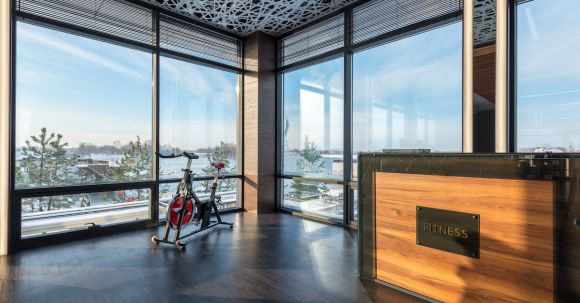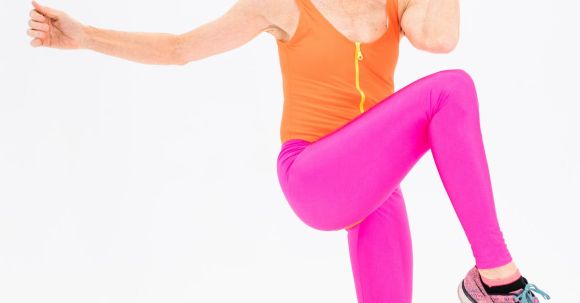Are you tired of trying different diets and workout programs that promise quick results but fail to deliver? Look no further, because Fit on is here to help you achieve the body you've always dreamed of. With its innovative approach to fitness and nutrition, Fit on is revolutionizing the way people get in shape. Say goodbye to fad diets and boring workouts, and say hello to a sustainable and enjoyable fitness journey.
Author: fit-on
Every athlete knows that to excel in their chosen sport, they need to have a strong and well-conditioned body. While regular exercise is beneficial for overall fitness, it is important to specifically train the muscles and skills required for your sport. This is where sports-specific workouts come into play. By tailoring your training to the demands of your sport, you can maximize your performance and minimize the risk of injury. In this article, we will explore the benefits of sports-specific workouts and provide some examples for various sports.
Enhancing Performance through Targeted Training
Sports-specific workouts are designed to mimic the movements, muscles, and skills required in a particular sport. By targeting these specific areas, athletes can enhance their performance and improve their overall game. Whether you are a runner, a basketball player, or a swimmer, focusing on exercises that replicate the demands of your sport will help you excel.Basketball: Jump Higher, Move Faster
Basketball is a dynamic sport that requires explosive power, agility, and endurance. To improve your performance on the court, incorporate exercises that target these specific areas. Plyometric exercises, such as box jumps and lateral bounds, can help increase your vertical jump and lateral quickness. Additionally, agility ladder drills and shuttle runs can improve your footwork and change of direction, allowing you to outmaneuver your opponents.Swimming: Power through the Water
Swimming is a full-body workout that requires strength, endurance, and proper technique. To enhance your swimming performance, incorporate exercises that target your upper body, core, and cardiovascular fitness. Pull-ups, shoulder presses, and planks can strengthen your upper body and core, enabling you to generate more power in the water. Additionally, interval training, such as high-intensity swimming sprints, can improve your cardiovascular endurance, allowing you to swim faster for longer periods.Soccer: Be Agile, Stay Strong
Soccer is a physically demanding sport that requires agility, speed, and strength. To excel on the field, incorporate exercises that focus on these areas. Agility ladder drills, cone drills, and shuttle runs can improve your footwork, quickness, and change of direction. Additionally, strength training exercises like squats, lunges, and deadlifts can enhance your lower body strength, allowing you to be more powerful in your kicks and tackles.Running: Build Endurance, Increase Speed
Running is a sport that requires both endurance and speed. To improve your running performance, incorporate exercises that target your cardiovascular fitness and leg strength. Long-distance runs and interval training can improve your endurance and increase your overall speed. Additionally, exercises like lunges, calf raises, and hamstring curls can strengthen your leg muscles, reducing the risk of injury and allowing you to maintain a faster pace.Conclusion: Train Smarter, Perform Better
In conclusion, sports-specific workouts are essential for athletes who want to excel in their chosen sport. By tailoring your training to the specific demands of your sport, you can enhance your performance and reduce the risk of injury. Whether you are a basketball player, swimmer, soccer player, or runner, incorporating exercises that mimic the movements and skills required in your sport will help you reach your full potential. So, train smart, play hard, and watch your performance soar to new heights.
Cardiovascular exercises, also known as cardio exercises or simply cardio, are widely recognized as an essential part of any fitness routine. They are great for improving cardiovascular health, burning calories, and promoting weight loss. However, many people are unsure about how frequently they should be incorporating cardio into their exercise regimen in order to achieve optimal results. In this article, we will delve into this important question and provide some guidance on the ideal frequency for doing cardio exercises.
Understanding the Basics of Cardio Exercises
Before discussing the frequency of cardio exercises, it is important to understand what they are and how they work. Cardio exercises are any activities that elevate your heart rate and increase your breathing rate over a sustained period of time. This can include activities such as running, cycling, swimming, dancing, or even brisk walking. These exercises primarily target the large muscles of the body, such as those in the legs and core, and require a continuous supply of oxygen to meet the increased demand.Finding the Right Balance
When it comes to cardio exercises, finding the right balance is key. Doing too little cardio may not yield the desired results, while doing too much can lead to overtraining and potential injury. The American Heart Association recommends at least 150 minutes of moderate-intensity aerobic activity or 75 minutes of vigorous-intensity aerobic activity per week. This translates to approximately 30 minutes of moderate-intensity cardio exercises, such as brisk walking, five days a week.Frequency and Intensity
The frequency of cardio exercises depends on various factors, including your fitness level, goals, and available time. For beginners, it is generally recommended to start with three to four sessions per week and gradually increase the frequency as your fitness improves. Intermediate and advanced individuals can aim for four to five sessions per week. In terms of intensity, cardio exercises can be classified into moderate and vigorous categories. Moderate-intensity exercises, such as brisk walking or light jogging, should make you break a sweat and breathe harder, but still allow you to carry on a conversation. On the other hand, vigorous-intensity exercises, such as running or high-intensity interval training (HIIT), should leave you breathless and make it difficult to talk.Variety and Progression
To avoid plateaus and keep your workouts interesting, it is important to incorporate a variety of cardio exercises into your routine. This not only helps to engage different muscle groups but also prevents boredom and monotony. You can mix and match activities such as running, cycling, swimming, dancing, or even group fitness classes. Additionally, it is important to progressively challenge yourself in order to continue seeing results. This can be done by increasing the duration, intensity, or frequency of your cardio exercises over time. For example, you can gradually increase your running distance or incorporate interval training to boost your cardiovascular fitness.Listening to Your Body
While guidelines can be helpful, it is important to listen to your own body and adjust your cardio routine accordingly. If you feel fatigued, sore, or unusually tired, it may be a sign that you need to take a rest day or reduce the intensity of your workouts. On the other hand, if you feel energized and ready for more, you can consider adding an extra session or increasing the intensity. In conclusion, the frequency of cardio exercises for optimal results depends on various factors, including your fitness level, goals, and available time. Starting with three to four sessions per week and gradually increasing the frequency as your fitness improves is a good guideline. It is important to incorporate a variety of cardio exercises into your routine and progressively challenge yourself over time. Most importantly, listen to your body and make adjustments as needed. By finding the right balance and staying consistent, you can achieve the best results from your cardio workouts.
The immune system plays a crucial role in keeping us healthy by protecting our bodies from harmful pathogens and diseases. With the ongoing pandemic and the constant threat of viruses, it has become more important than ever to strengthen our immune system. While there are various ways to boost immunity, one effective and holistic approach is through the practice of yoga and meditation. In this article, we will explore how yoga and meditation can strengthen your immune system and improve your overall well-being.
Reducing Stress and Boosting Immunity
Chronic stress can weaken the immune system, making us more susceptible to illnesses. Fortunately, yoga and meditation are powerful tools in combating stress. The deep breathing techniques employed in yoga help activate the relaxation response, reducing the production of stress hormones like cortisol. Meditation, on the other hand, allows us to quiet our minds and find inner peace. By regularly practicing yoga and meditation, we can manage stress more effectively, which in turn strengthens our immune system.Enhancing Respiratory Function
Respiratory health is of utmost importance, especially during a respiratory virus outbreak. Yoga and meditation can significantly improve lung function and enhance the respiratory system. Deep breathing exercises in yoga help increase lung capacity and improve oxygen intake. This not only strengthens the lungs but also increases the efficiency of the immune system. Additionally, meditation practices like alternate nostril breathing can clear the nasal passages and prevent respiratory infections.Boosting Blood Circulation
A healthy immune system relies on good blood circulation to transport nutrients, oxygen, and immune cells throughout the body. Yoga poses and meditation techniques stimulate blood flow, improving circulation and enhancing the functioning of the immune system. Poses like the downward dog, headstand, and shoulder stand promote blood circulation to vital organs, ensuring that they receive a sufficient supply of nutrients and oxygen. Meditation, with its focus on relaxation and deep breathing, also helps improve blood circulation.Stimulating the Lymphatic System
The lymphatic system is responsible for removing toxins, waste, and pathogens from the body. However, unlike the cardiovascular system, the lymphatic system does not have a pump to facilitate circulation. Yoga poses that involve twisting, bending, and stretching help stimulate the lymphatic system, aiding in the elimination of toxins and boosting the immune response. Practices like the seated twist, cobra pose, and bridge pose are particularly effective in this regard.Promoting Mind-Body Connection
Yoga and meditation are not just physical practices; they also cultivate a strong mind-body connection. This connection is vital for overall well-being and plays a crucial role in maintaining a healthy immune system. By practicing yoga and meditation, we become more attuned to our bodies, allowing us to listen to its needs and respond accordingly. This self-awareness enables us to make healthier choices in terms of nutrition, sleep, and lifestyle, all of which contribute to a strong immune system.Incorporating Yoga and Meditation Into Your Routine
To reap the benefits of yoga and meditation, it is essential to make them a part of your daily routine. Start by setting aside a specific time each day for your practice. Begin with simple yoga poses and gradually increase the duration and intensity as you progress. Explore different meditation techniques and find the one that resonates with you the most. Remember, consistency is key when it comes to strengthening your immune system with yoga and meditation. In conclusion, yoga and meditation offer a holistic approach to strengthening the immune system. By reducing stress, enhancing respiratory function, boosting blood circulation, stimulating the lymphatic system, and promoting the mind-body connection, these practices contribute to overall well-being and immunity. Incorporating yoga and meditation into your daily routine can be a powerful tool in maintaining good health, especially during these challenging times. So, roll out your yoga mat, find a quiet spot, and embark on a journey towards a stronger immune system and a healthier life.Introduction
Are you an athlete looking to take your game to the next level? Do you want to improve your performance and enhance your skills in your chosen sport? If so, then sports-specific training is the key to unlocking your athletic potential. In this article, we will explore the importance of sports-specific training and how it can help you become a better athlete.Understanding Sports-specific Training
Sports-specific training is a targeted approach to training that focuses on the specific demands and movements of a particular sport. It involves tailoring your workouts and exercises to mimic the movements and skills required in your sport. By doing so, you can improve your performance and reduce the risk of injuries.The Benefits of Sports-specific Training
1. Enhanced Performance
One of the main benefits of sports-specific training is that it can significantly improve your performance in your chosen sport. By training specifically for the movements and skills required in your sport, you can enhance your agility, speed, strength, and endurance. This targeted approach allows you to become more efficient and effective in your movements, giving you a competitive edge over your opponents.2. Injury Prevention
Another crucial advantage of sports-specific training is its ability to reduce the risk of injuries. By focusing on the specific movements and skills of your sport, you can strengthen the muscles and joints involved, improving their stability and resilience. Additionally, sports-specific training can help correct any muscle imbalances or weaknesses, which can often lead to injuries. By training in a sport-specific manner, you can minimize the risk of common sports-related injuries.3. Skill Development
Sports-specific training is not just about physical fitness; it also plays a vital role in skill development. By practicing the specific skills and techniques of your sport, you can improve your coordination, timing, and accuracy. This targeted practice allows you to refine your skills and become more proficient in executing them during competitions.How to Incorporate Sports-specific Training into Your Routine
1. Analyze Your Sport
The first step in incorporating sports-specific training into your routine is to analyze your sport. Identify the key movements, skills, and physical demands of your sport. This analysis will guide you in designing your training program.2. Design a Training Program
Once you have analyzed your sport, it's time to design a training program that focuses on the specific demands of your sport. This program should include exercises and drills that mimic the movements and skills required in your sport. It should also incorporate strength training, conditioning, and flexibility exercises to enhance your overall athletic performance.3. Seek Professional Guidance
If you're new to sports-specific training or want to take your training to the next level, it's recommended to seek professional guidance. A qualified coach or trainer can help you design a customized training program that suits your needs and goals. They can also provide valuable feedback and guidance to ensure you're performing the exercises correctly and safely.Conclusion: Unlock Your Full Athletic Potential
Sports-specific training is a game-changer for athletes. By tailoring your training to the specific demands of your sport, you can enhance your performance, reduce the risk of injuries, and improve your skills. So, if you're looking to unlock your full athletic potential, incorporate sports-specific training into your routine and watch yourself reach new heights in your chosen sport.
When it comes to fitness, finding the right balance between strength training and cardio exercises is essential. While cardio workouts help improve your endurance and burn calories, incorporating Pilates into your routine can provide numerous benefits for your overall fitness and well-being. Pilates is a low-impact exercise method that focuses on core strength, flexibility, and body awareness. In this article, we will explore how you can seamlessly integrate Pilates into your cardio workouts to maximize your results.
Understanding the Benefits of Pilates
Before we dive into the ways you can incorporate Pilates into your cardio workouts, let's first understand the benefits it can offer. Pilates helps improve your posture, strengthens your core muscles, increases flexibility, and enhances body control. By incorporating Pilates into your cardio routine, you can enhance your overall fitness level, prevent injuries, and achieve better results from your workouts.Start with a Pilates Warm-up
To begin incorporating Pilates into your cardio workouts, it is crucial to warm up your muscles properly. Start with a Pilates warm-up routine that focuses on mobilizing your joints, activating your core, and stretching your muscles. This will prepare your body for the intense cardio exercises that lie ahead and help prevent any potential injuries.Integrate Pilates Movements into Your Cardio Exercises
One effective way to incorporate Pilates into your cardio workouts is by integrating Pilates movements into your existing exercises. For example, if you enjoy running or jogging, you can add Pilates-inspired movements such as leg circles or single leg stretches during your cool-down period. These movements will not only help improve your core stability but also add variety to your routine.Combine Pilates with High-Intensity Interval Training (HIIT)
High-Intensity Interval Training (HIIT) is an excellent way to boost your cardiovascular fitness and burn calories efficiently. To incorporate Pilates into your HIIT workout, consider adding Pilates-based exercises such as planks, side planks, or Pilates push-ups in between your high-intensity intervals. This combination will challenge your core strength while keeping your heart rate elevated.Try Pilates Equipment during Cardio Workouts
If you have access to Pilates equipment such as the reformer or the stability chair, incorporating them into your cardio workouts can take your fitness routine to the next level. For example, you can perform cardio exercises like jumping jacks or mountain climbers on the reformer, which adds resistance and engages your core muscles even more. Using Pilates equipment during your cardio workouts can provide an added challenge and help you achieve better results.End with a Pilates Cool-down
After completing your cardio workout, it is essential to cool down your body and stretch your muscles. Incorporating Pilates moves into your cool-down routine can help improve your flexibility and enhance recovery. Moves like the roll-up or the spine stretch forward can be excellent choices to stretch your back and hamstrings while focusing on your breath and body control.Conclusion: Elevate Your Cardio Workouts with Pilates
Incorporating Pilates into your cardio workouts can provide numerous benefits for your overall fitness and well-being. By starting with a Pilates warm-up, integrating Pilates movements into your cardio exercises, combining Pilates with HIIT, trying Pilates equipment, and ending with a Pilates cool-down, you can enhance your core strength, flexibility, and body awareness. So, why not give it a try and elevate your cardio workouts with the power of Pilates? Your body will thank you for it!
Exercise is an essential part of maintaining a healthy lifestyle. It not only helps in weight management but also plays a significant role in keeping our hearts strong and healthy. Cardiovascular exercises, also known as aerobic exercises, are particularly effective in improving cardiovascular health and offer a wide range of benefits. Let's explore some of these benefits in detail.
Increased Heart Strength
One of the most significant benefits of cardiovascular exercises is the strengthening of the heart muscle. Regular aerobic workouts help to improve the efficiency of the heart by making it stronger. When you engage in activities such as running, swimming, or cycling, your heart pumps more blood, which helps to increase the strength and size of the heart muscles. This, in turn, improves your overall cardiovascular health and reduces the risk of heart disease.Improved Stamina and Endurance
Cardiovascular exercises also help to improve stamina and endurance levels. When you perform aerobic exercises regularly, your body adapts to the increased demand for oxygen and energy. This leads to improved lung capacity and enhanced oxygen delivery to the muscles, which allows you to exercise for longer periods without getting tired easily. Improved stamina and endurance not only benefit your exercise routine but also make daily activities easier to manage.Weight Management and Fat Loss
Cardiovascular exercises are an effective way to manage weight and burn excess fat. These exercises increase your heart rate, which helps to boost metabolism and burn calories. When combined with a healthy diet, regular aerobic workouts can contribute to weight loss by creating a calorie deficit. Additionally, cardiovascular exercises help to reduce belly fat, which is associated with an increased risk of heart disease and other health conditions.Reduced Risk of Chronic Diseases
Engaging in regular cardiovascular exercises can significantly reduce the risk of chronic diseases such as heart disease, stroke, and diabetes. These exercises improve blood circulation and lower blood pressure, reducing the strain on the heart and blood vessels. They also help to improve cholesterol levels by increasing the levels of high-density lipoprotein (HDL) or "good" cholesterol and decreasing the levels of low-density lipoprotein (LDL) or "bad" cholesterol. By reducing the risk of chronic diseases, cardiovascular exercises contribute to a longer and healthier life.Mental Health Benefits
Cardiovascular exercises not only benefit physical health but also have positive effects on mental health. When you engage in aerobic exercises, your body releases endorphins, which are known as "feel-good" hormones. These hormones help to reduce stress, anxiety, and depression, promoting a positive mood and overall mental well-being. Regular aerobic workouts can also improve sleep quality, boost self-esteem, and enhance cognitive function.Improved Energy Levels
Regular cardiovascular exercises help to increase energy levels by improving blood circulation and oxygen supply throughout the body. When you engage in aerobic activities, your body becomes more efficient at utilizing oxygen and nutrients, which leads to increased energy production. Improved energy levels not only make daily tasks more manageable but also enhance athletic performance, allowing you to push harder and achieve better results in your workouts. In conclusion, cardiovascular exercises offer a multitude of benefits for both physical and mental health. They strengthen the heart, improve stamina and endurance, aid in weight management, reduce the risk of chronic diseases, boost mental health, and increase energy levels. By incorporating regular aerobic workouts into your routine, you can enjoy these benefits and lead a healthier, happier life. So, lace up your sneakers, hit the gym, or head out for a jog, and start reaping the rewards of cardiovascular exercises today.
In today's fast-paced world, it can be challenging to find time for exercise. With long work hours, family responsibilities, and other commitments, it's no wonder that many people struggle to stay active and fit. However, staying active doesn't have to mean spending hours at the gym or going for long runs. There are plenty of ways to incorporate physical activity into your daily routine, even from the comfort of your own home. In this article, we will explore some simple and effective ways to stay active and fit at home.
Create a Home Workout Routine
One of the easiest ways to stay active at home is to create a home workout routine. This can be as simple as setting aside a specific time each day to do a workout. You can start with basic exercises like push-ups, squats, lunges, and planks. As you progress, you can add more challenging exercises or invest in some basic equipment like resistance bands or dumbbells to increase the intensity of your workouts.Take Advantage of Online Exercise Classes
The internet has made it easier than ever to access a wide variety of exercise classes from the comfort of your own home. From yoga to HIIT workouts, there are countless options available online. Many fitness influencers and trainers offer free or low-cost workout programs that you can follow along with. These classes are a great way to stay motivated and add variety to your home workout routine.Incorporate Physical Activity into Your Daily Routine
Staying active doesn't have to mean dedicating a specific time to exercise. You can easily incorporate physical activity into your daily routine. For example, instead of taking the elevator, take the stairs. Instead of sitting on the couch during TV commercials, do some quick stretches or jog in place. Small changes like these can add up and make a big difference in your overall fitness level.Get Creative with Household Chores
Household chores may not be the most exciting activity, but they can be a great way to stay active. Gardening, vacuuming, mopping the floors, and washing windows are all physical activities that can help you burn calories and stay fit. Plus, you'll have a clean and organized home as an added bonus!Make Time for Regular Stretching
Stretching is often overlooked but is an essential part of any fitness routine. Regular stretching can help improve flexibility, prevent injuries, and reduce muscle soreness. Take a few minutes each day to stretch your muscles, focusing on areas that tend to get tight, such as your hamstrings, hips, and shoulders. You can find plenty of stretching routines online to guide you through a proper stretching session.Stay Active Throughout the Day
Even if you have a sedentary job, there are still ways to stay active throughout the day. Take short, frequent breaks to walk around, stretch, or do a quick exercise routine. Set a reminder on your phone or computer to ensure that you don't forget to move. Consider investing in a standing desk or a stability ball chair to promote better posture and engage your muscles while working.Conclusion: Stay Active and Fit, Right at Home
Staying active and fit doesn't have to be a challenge, even if you can't make it to the gym. By creating a home workout routine, taking advantage of online exercise classes, incorporating physical activity into your daily routine, getting creative with household chores, making time for regular stretching, and staying active throughout the day, you can easily stay on top of your fitness goals from the comfort of your own home. So, lace up your sneakers, turn on some energetic music, and start moving!
Are you tired of trying multiple diets and exercise programs with no success? Do you dream of achieving your weight loss goals and finally feeling confident in your own body? Look no further than Fit on, the revolutionary fitness program that is changing lives across the globe.
Introduction
In a world saturated with weight loss fads and quick-fix solutions, it can be challenging to find a program that truly delivers on its promises. Fit on, however, stands apart from the rest. With its unique approach to fitness and nutrition, Fit on has helped thousands of individuals transform their bodies and their lives.Unleash Your Potential
Fit on believes that everyone has the potential to achieve their weight loss goals. Whether you have struggled with your weight for years or are just beginning your journey, Fit on provides the guidance and support you need to succeed. Through a combination of personalized workout plans, expert nutritional advice, and a supportive community, Fit on empowers you to take control of your health and transform your body.Tailored to Your Needs
One of the key factors that sets Fit on apart is its personalized approach to fitness. Unlike generic workout programs, Fit on takes into account your individual goals, fitness level, and preferences. By tailoring the workouts to your specific needs, Fit on ensures that you are not only challenging yourself but also enjoying the process. From high-intensity interval training to yoga and Pilates, Fit on offers a wide range of workouts to keep you motivated and engaged.Fuel Your Body, Fuel Your Success
Achieving sustainable weight loss is not just about exercise; it also requires a healthy, balanced diet. Fit on understands the importance of proper nutrition and provides expert guidance to help you make informed choices. With customized meal plans, delicious recipes, and nutrition tips, Fit on makes it easy to fuel your body for success. Say goodbye to restrictive diets and hello to a healthy, sustainable eating plan that supports your weight loss journey.Community Support
Embarking on a weight loss journey can be daunting, but with Fit on, you don't have to go it alone. The Fit on community is a supportive network of like-minded individuals who are all working towards their own fitness goals. Connect with others, share your progress, and gain inspiration from those who have already achieved incredible results. The Fit on community is there to cheer you on every step of the way.Results That Speak for Themselves
The success stories of Fit on speak for themselves. Countless individuals have experienced life-changing weight loss and improved overall wellness through the program. From shedding pounds and inches to gaining confidence and energy, Fit on has transformed the lives of its members. Don't just take our word for it – see the incredible transformations for yourself on the Fit on website.Conclusion
If you are ready to experience life-changing weight loss and finally achieve the body you've always dreamed of, look no further than Fit on. With its personalized approach, expert guidance, and supportive community, Fit on is the key to unlocking your full potential. Say goodbye to endless dieting and start your journey to a healthier, happier you with Fit on. Join the fitness revolution today and start experiencing the transformative power of Fit on.
When it comes to improving your athletic performance, generic workouts may not always cut it. If you want to excel in a specific sport, it's essential to incorporate sports-specific exercises into your training routine. These exercises target the specific muscles and movements required for your chosen sport, helping you enhance your skills and reach your full potential. In this article, we will explore the benefits of sports-specific exercises and provide some examples to help you take your fitness to the next level.









